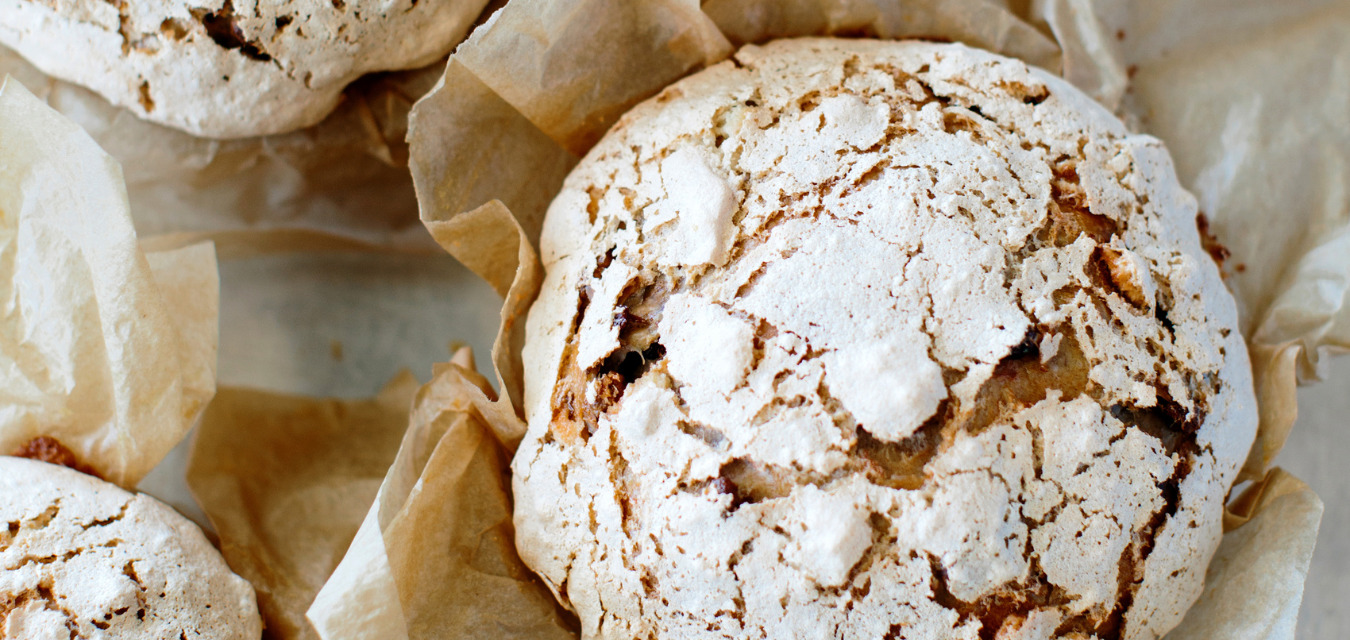recipe 
yields
Make 2 loaves
3½ cups bread flour
2 teaspoons instant yeast
1½ teaspoons fine sea salt plus more for egg wash
½ cup unsalted butter, cold
1 cup whole milk, at room temperature
2 large eggs, at room temperature and beaten
⅓ cup sugar
¾ cup dried cranberries, soaked in 4 tablespoons rum for 24 hours
½ cup toasted pecans
1 teaspoon cinnamon
½ teaspoon pepper
3 tablespoons sugar
⅓ cup almond flour
¾ cup powdered sugar
¾ cup egg whites (from 3-6 eggs, depending on size)
For the brioche
For the candied almond meringue:
steps
- To a medium bowl, add flour, yeast, and salt. Combine and set aside. Soften cold butter by beating with a rolling pin until malleable—it should be soft, but not oily. In another bowl, combine milk and beaten eggs and mix well. Using instant-read thermometer, measure temperature of milk; it should read between 75 and 80 degrees.
- To the bowl of a stand mixer fitted with dough hook attachment, add half of milk mixture, then add flour mixture. (Adding some liquid first keeps dry ingredients from sticking to the bottom of the bowl.) Mix on low speed, gradually adding remaining milk mixture until a soft, shaggy dough forms. (Be careful not to add milk too late, as it becomes difficult to incorporate once dough has formed.) Stop mixer often to scrape hook and sides of bowl with a rubber spatula.
- Once dough has formed, mix on low speed for 5 minutes. Sprinkle in a third of the sugar. Begin mixing again on medium-low speed and, over the course of 5 minutes, add remaining sugar in two more batches. After 5 minutes on medium-low speed, add softened butter, a few tablespoons at a time, mixing until butter is incorporated and dough is smooth. This should take about 5 minutes. Add soaked cranberries, pecans, cinnamon, and espelette, and mix until incorporated.
- Turn dough onto a lightly floured surface. Using thermometer, check temperature of dough; it should be between 72 and 80 degrees. (If it’s higher than 80 degrees, refrigerate dough in 15-minute increments until desired temperature is reached. If it’s lower, adjust time of fermentation in next step.)
- Lightly dust the inside of a large glass or metal bowl with flour and transfer dough to bowl, smooth side up. Cover bowl loosely with plastic wrap—the plastic should not touch the dough. If it does, very lightly dust top of dough with flour to prevent plastic from sticking. Let dough sit in a draft-free place that is around 70 degrees for about 45 minutes. If the dough’s temperature was lower than 72 degrees after mixing, let it ferment for an additional 10 minutes for every 2 degrees below 72. Then, repeat folding process and ferment an additional 45 minutes. Place dough in refrigerator for 3 hours.
- Turn dough out onto a floured surface and divide in half. Set one half aside. To shape remaining dough, pull one edge to the center and press lightly; turn dough one quarter and repeat folding process three more times, taking care to stretch the dough gently, without pulling or tearing it. When you have done all four corners, gently pick up dough to make sure that it is not sticking to the work surface. The dough should now be a fairly smooth, almost round shape. Turn dough over so smooth side is facing up. Then, lay the dough so it is leaning slightly to one side to create tension on the round. Place your hands behind the dough in a triangle shape with your fingertips touching over the back side of the dough and the sides of your hands touching the work surface. Gently pull the ball-shaped dough toward your body, in the process pressing the ball into an oval shape. In one quick motion, move your hands to the left side of the oval and round up the shape by pushing to the right side. Continue with this motion, rotating the dough a quarter-turn each time, until each side of the dough has been pushed in a circular motion moving to the right. Pick up the dough and repeat the process until the dough has become a tight, round, smooth ball that is sealed on the bottom. (The ball should have a bit of a spring to it and the exterior should feel as though it is covered in a fine, firm skin or, as Vatinet likes to say, “smooth as a baby’s bottom.”) Transfer to a parchment-lined 6-inch round pan and repeat shaping process with second portion of dough.
- Move to a draft-free place for 2 to 3 hours—but keep a close eye as you cannot fix dough that is over-proofed (meaning it was allowed to sit too long). To test if loaves are ready to bake, gently press a finger into dough to make a small indentation. If the indentation slowly disappears, it’s ready to bake. If it quickly bounces back, let the dough ferment another 20 minutes and check again. If it quickly bounces back again, wait another 10 minutes. If after a total of 30 minutes, the indentation still disappears quickly, check at 5-minute intervals. (If indentation causes entire dough to deflate, it is over-proofed; the interior texture and flavor will be off when baked.) Meanwhile, preheat oven to 400 degrees and position rack just below the center.
- Make the meringue: In heavy-bottomed pot over medium heat, combine sugar and 2 tablespoons water and cook to 240 degrees. Stir in almond flour, transfer to a parchment-lined sheet pan, and let cool. Once cool, break candied almond flour into small pieces. Next, in the bowl of a stand mixer fitted with whisk attachment, whip powdered sugar and egg whites on high speed until fluffy and shiny, about 4 to 5 minutes. Using a rubber spatula, fold in candied almond flour pieces.
- Once dough is ready, smooth meringue on top of loaves with spatula. Bake until loaf is deep golden and the meringue begins to change color and crackle, about 25 minutes. Let cool completely on a wire rack.
From The Rise of La Farm.
Date Published: 05.01.20
share
-
Recipe By
Lionel Vatinet, La Farm Bakery, Cary, North Carolina






